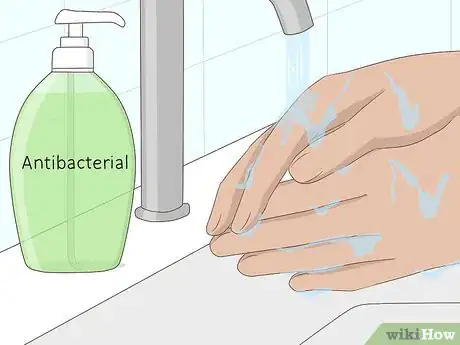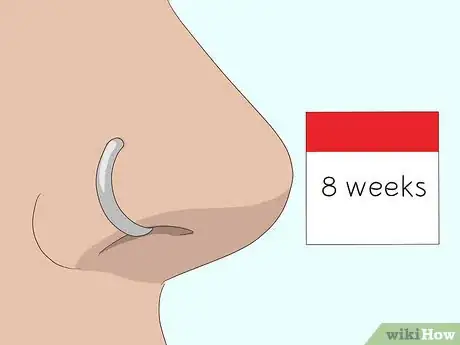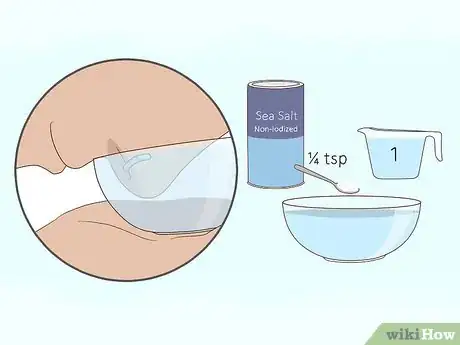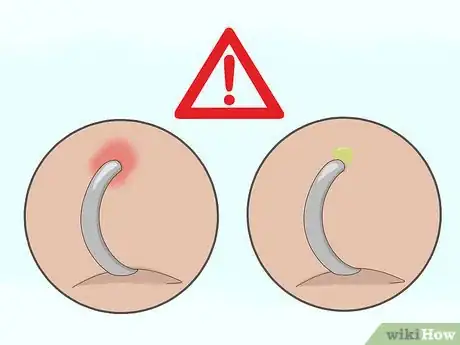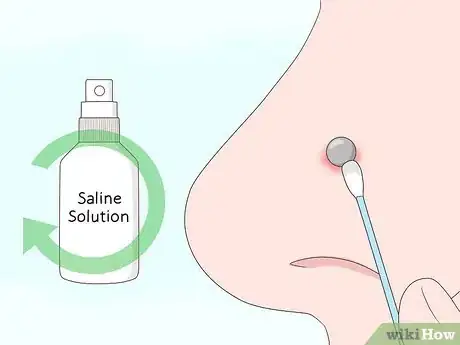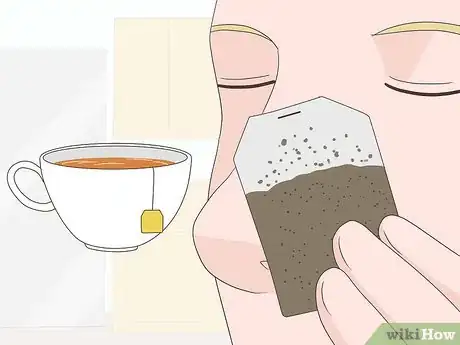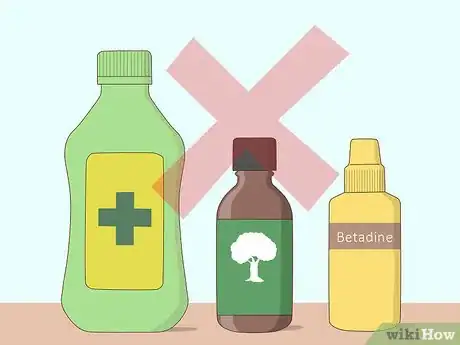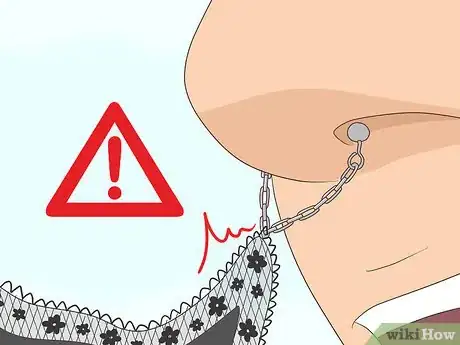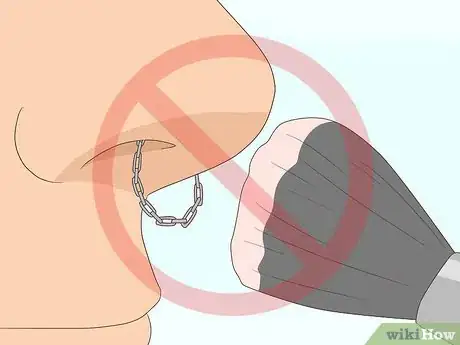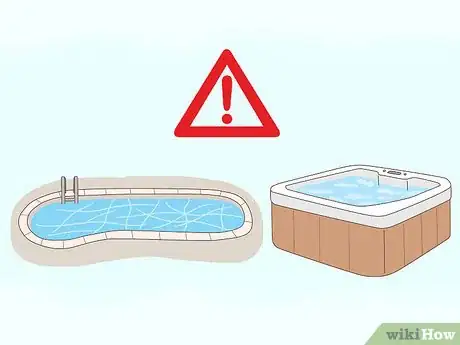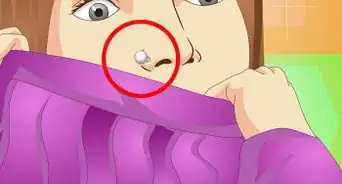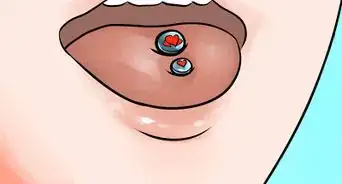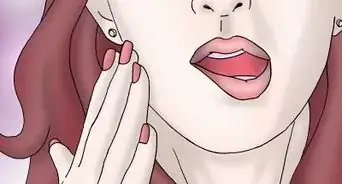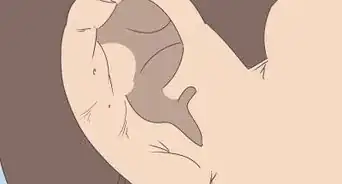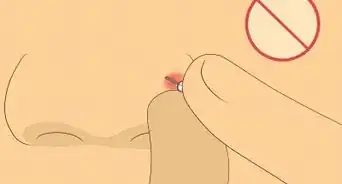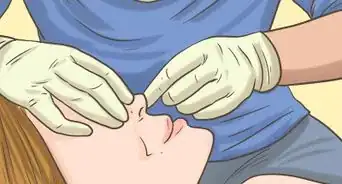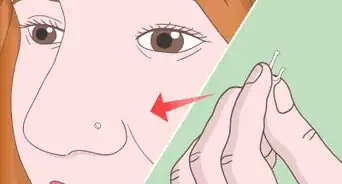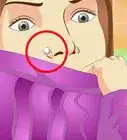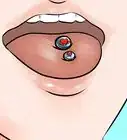This article was co-authored by Stephanie Anders. Stephanie Anders is the Owner and Head Piercer at Royal Heritage Tattoo and Piercing, a tattoo and piercing studio located in Los Angeles, California. Stephanie has over 10 years of piercing experience and her client list includes such stars as Jennifer Aniston, Jessica Alba, Cameron Diaz, Nicole Richie, Gwyneth Paltrow, and Sharon Osbourne.
wikiHow marks an article as reader-approved once it receives enough positive feedback. This article received 11 testimonials and 100% of readers who voted found it helpful, earning it our reader-approved status.
This article has been viewed 1,141,983 times.
Getting a new piercing is always an exciting addition to anyone's look. However, it can quickly turn into a nightmare if the area gets infected soon after the piercing. Some people are more prone to infections than others, but all it takes is a few simple steps to keep a healthy healing nose piercing from turning into an infection.
Steps
Healing Your Nose Piercing
-
1Get your piercing done by a professional. It's common knowledge among those in the body modification community that there is a right way and a wrong way to get a piercing done. You want to go to a place that has a good standing reputation with experienced piercers. If you take the time and effort to visit a professional, your piercing has a much better chance of healing correctly and faster. Also, professional piercers will offer expert advice to help you take care of your piercing after you leave.[1] Some things to ensure you have a safe piercing include:
- A hollow piercing needle. Professional body piercers use these needles because they're hygienic and easy to control, for straight and properly-placed piercings that heal quickly.[2]
- Avoid piercing guns. Using a nose piercing gun is likely to cause more pain and aren't normally used for nose piercings because they can be less accurate. Besides, since piercing guns are sometimes harder to clean, they can easily transfer blood-borne infections.[3]
-
2Use clean hands to handle your piercing. You want to wash your hands with anti-bacterial soap anytime you touch and handle your piercing.[4] Your face already has oils on it, and those oils, along with the secretions coming from your freshly pierced nose (clear fluids, sometimes blood), and dirt on your hands, can lead to an infection.Advertisement
-
3Leave the jewelry in the piercing. Once you are pierced, you shouldn't remove the jewelry from your nose for at least 6-8 weeks, which is considered the normal healing time. The only time you should remove the original jewelry, is if there is something wrong with the size or material of the jewelry.
- If you want to change your jewelry while your piercing is still healing stage (6-8 weeks after the initial piercing), you should contact your piercer and have them do it for you.
-
4Clean your piercing regularly. You want to be gentle with your new piercing. First, your should use a cotton ball or q-tip with water to wipe off any built up crust that may have formed. While initially you might think cleaning with alcohol or peroxide would kill all of the bacterial cells, they also happen to kill the healing cells in and on your nose, so don't use those harsh cleaners. A safe and easy way to clean a new piercing is by using a saline solution. Sea salt dissolved in water is a gentle and effective saline solution. You can soak a cotton ball or q-tip in the saline solution, or you can soak your nose piercing in a bigger bowl of the saline solution. If you soak your nose piercing, you should soak it for 5-10 minutes at least once a day. After your soak, you can rinse your nose with clean water to remove any leftover saline solution. To make this saline solution at home you will need:
- 1/4 teaspoon of non-iodized (iodine-free) sea salt.
- 1 cup (8 oz.) of warm distilled or bottled water.
EXPERT TIPJef Saunders has been piercing professionally for over 20 years. He is the Public Relations Coordinator for the Association of Professional Piercers (APP), an international non-profit dedicated to the educating the public on vital health and body piercing safety, and he teaches piercing for the Fakir Intensives. In 2014, Jef was elected to the Association of Professional Piercers' Board of Directors. In 2015, Jef received the APP President’s Award from Brian Skellie.Professional Piercing Expert
 Jef Saunders
Jef Saunders
Professional Piercing ExpertOur Expert Agrees: The most commonly recommended advice is to rinse and wipe your piercing with a saline solution regularly. The climate you live in can affect how often your rinse your piercing. Wetter climates can cause more swelling and require more cleaning. Drier climates need more limited cleaning with less swelling.
-
5Look for signs of infection. Sometime a piercing will obviously be infected. Other times, the infection might not be so easy to identify. When you first get a piercing done, there might be some initial bleeding, swelling around the piercing site, sensitivity, bruising, itchy irritation, and a whitish-yellow discharge (which is not pus) coming from the piercing. This discharge can form some crust on the jewelry, but that crust formation is okay and normal. Knowing the difference between normal side effects after having a piercing done, and infection side effects, can help you treat your infection better. Some of the most common signs that your piercing is infected is:
- Persistent itchiness and/or redness that continues after the normal healing period.
- Persistent soreness and tenderness that continues after the normal healing period.
- A hot, burning sensation.
- Yellow-green seepage of liquid, such as pus or blood, from the hole.
- Bad smells coming from the piercing site.[5]
Taking Care of Infections
-
1Check your symptoms. An infection and an allergic reaction have similar symptoms, so the best way to distinguish between the two is to know how they differ from one another: An allergic reaction is different from an infection, in that an allergic reaction includes a severe burning feeling, a bigger hole from the initial piercing (as if the skin is trying to move away from the metal stem of the piercing), and a clearish-yellow discharge rather than a discharge that is yellow-greenish. If you think you are experiencing an allergic reaction, you should have your piercer change out the piercing jewelry immediately, and visit a doctor.
- Some metals can cause an allergic reaction, so it is best to use quality metal studs made from things like surgical steel, titanium, platinum, niobium, and gold if it is 14k or higher.
-
2Maintain your cleaning regimens. Continuing to clean your piercing with soap and water or a saline solution will help to wash out the bacteria causing the infection. A nose piercing infection can be caused by a number of things such as the entry of outside pathogens (bacteria and fungi), wearing very tight jewelry, or unhygienic ways of living. Just be sure to keep cleaning your piercing regularly until it fully heals, (normally 6-8 weeks after getting it pierced).
-
3Try some at home remedies. If your infection site doesn't seem to be too bad, you can try curing it yourself at home before you visit the doctor. You can try things like:
- Warm saline compresses promote blood flow to the infected area (more blood means more infection fighting cells) which can promote healing the infection quicker.[6]
- Cold compresses can help reduce swelling, aches, and pains near the infected piercing. Just like when you bang your knee on the corner of a coffee table, a cold compress can also help reduce bruising. Be sure to never apply ice directly to the site of your piercing. Direct contact with ice can cause skin damage. Be sure to always wrap a paper towel or some sort of cloth around the cold compress before putting it on the piercing area.[7]
- Chamomile tea bag compress. Make a chamomile tea compress by dipping a chamomile tea bag into warm water. Let the bag steep in the water for about 20 seconds, and then apply the tea bag to the area of your piercing. Hold it there as a compress for about 10 minutes, or until the bag cools. Once the tea bag cools, dip the tea bag back into the warm water, and apply it as a compress again.[8]
- Aspirin paste. Place a some aspirin into a glass (about 4-6 tablets) with very little water and allow some time for the aspirin to dissolve in the water and turn into a paste. Apply the aspirin paste onto the infection site before you go to bed every night, and look for signs of improvement with the infection. Since aspirin is an anti-inflammatory drug, it can reduce the swelling, help heal your infection without much of a risk for irritation, and it still lets the infection site drain fluids.[9]
-
4Avoid using strong disinfectants. With regular cleaning you want to avoid harsh cleansers, but even more so with an infected piercing. People who have infected piercings should steer clear from substances like alcohol, tea tree oil, betadine, hydrogen peroxide and methylated spirits, because scar and bumps are more like to form around the infected piercing site with the use of these substances.[10]
- The chemical strength of these substances can cause even more discomfort with burning sensations, and they kill off the good cells trying to fight the infection.
- Other anti-bacterial ointments can possibly prevent air flow from getting to the infected area and slow down healing, so if you use them, use them sparingly.[11]
-
5Seek medical attention. If your infection doesn't clean up or get any better within a few days (a week maximum), the best thing you can do for your infected piercing is to take the details of your problem to a doctor. Dermatologists and general-practice physicians are your best choice; however, if you can't afford to visit a doctor's office or clinic, speaking to the person who did your piercing is your next best choice.[12]
Keeping a Healthy Piercing
-
1Be careful not to irritate your piercing. Be careful when getting dressed and undressed. It can be very painful to catch a new piercing on your clothes when you're putting them on or taking them off. Give yourself an extra couple of minutes to get dressed so you can take your time, move carefully, and avoid snagging your nose ring on your clothes.
- Some people try to sleep on their opposite side of where their nose piercing is, or use a neck pillow so they don't irritate it in their sleep.
-
2Keep makeup away from the piercing site. While your piercing is trying to heal, be sure to stay away from using lotions, makeup, or any face washes that could get into, and build up in the piercing hole. If you do get any products in the piercing, rinse the piercing with warm salt water or a saline solution.
-
3Avoid contact with non-sterile water. Water sources like lakes, public or private swimming pools, and hot tubs are all areas that could contain contaminants that can develop an infection for a newly pierced nose. If your nose piercing must come in contact with these potentially dangerous water sources, try to use a bandage that is fully water-proof, and completely seals the piercing. Bandages like these can be found at any local drugstore.[13]
Community Q&A
-
QuestionIs it normal for me to have to force the pin through my nose piercing and sometimes having blood and pus three weeks after the piercing? I have to change the piercing frequently because they aren't allowed at school.
 Community AnswerThis is probably because the piercing hasn't healed yet. By removing and putting it back in several times a week, the nose is closing up over the piercing leaving you to re-pierce through the skin all over again.
Community AnswerThis is probably because the piercing hasn't healed yet. By removing and putting it back in several times a week, the nose is closing up over the piercing leaving you to re-pierce through the skin all over again. -
QuestionIs it normal to have redness and pain around the pierced nose after a week?
 Community AnswerYes, your nose may just be healing. If it persists, see a doctor.
Community AnswerYes, your nose may just be healing. If it persists, see a doctor. -
QuestionI had to take my nose piercing out, it was hurting way too bad because I got it done with a gun. Will my nose be okay since I took out the piercing, or will the bump get worse?
 Community AnswerKeep it clean and make sure you wash your hands before touching it. Guns are not recommended, because you can't clean them as well as a needle. To get rid of the bump, try a sea salt solution or an aspirin paste.
Community AnswerKeep it clean and make sure you wash your hands before touching it. Guns are not recommended, because you can't clean them as well as a needle. To get rid of the bump, try a sea salt solution or an aspirin paste.
Warnings
- If you have sensitive skin, you may need to clean it LESS than 2-3 times a day because it will irritate the piercing.⧼thumbs_response⧽
- Never use petroleum based products such as Neosporin. Also, don't ever use alcohol, peroxide, or pure iodine on your piercing.⧼thumbs_response⧽
- Infections in this area can be serious, resulting in meningitis or a brain abscess.⧼thumbs_response⧽
References
- ↑ Stephanie Anders. Piercing Specialist. Expert Interview. 4 December 2019.
- ↑ https://www.wikihow.com/Heal-Piercings
- ↑ http://www.skin-artists.com/nose-piercing-healing.htm
- ↑ Stephanie Anders. Piercing Specialist. Expert Interview. 4 December 2019.
- ↑ http://www.skin-artists.com/nose-piercing-healing.htm
- ↑ http://www.healcure.org/piercing/infected-piercing/piercing-infection-care-cleaning-treatment-signs-and-symptoms/
- ↑ http://www.healcure.org/piercing/infected-piercing/piercing-infection-care-cleaning-treatment-signs-and-symptoms/
- ↑ http://www.newhealthguide.org/Nose-Piercing-Bump.html
- ↑ http://www.newhealthguide.org/Nose-Piercing-Bump.html
About This Article
To heal your new nose piercing, leave your nose ring in for at least 6 to 8 weeks and always wash your hands before touching it. During that time, regularly clean your piercing by soaking it in a saltwater solution, which you can purchase at a pharmacy, for 5 to 10 minutes a day. You can make your own saline solution at home by dissolving ¼ teaspoon of iodine-free sea salt in a cup of warm distilled water. If you think your piercing is infected, look for symptoms like itchiness, redness, and soreness that won’t go away. You might also notice a bad smell or yellow-green pus coming out of the hole. While many infections go away with proper cleaning, you should see a doctor for treatment if it doesn’t clear up within a week. For more help, like how to keep your piercing from getting irritated, scroll down.


